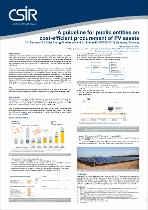JavaScript is disabled for your browser. Some features of this site may not work without it.
- ResearchSpace
- →
- Research Publications/Outputs
- →
- Conference Publications
- →
- View Item
| dc.contributor.author |
Bischof-Niemz, T

|
|
| dc.contributor.author |
Roro, Kittessa T

|
|
| dc.date.accessioned | 2017-11-08T07:15:50Z | |
| dc.date.available | 2017-11-08T07:15:50Z | |
| dc.date.issued | 2015-09 | |
| dc.identifier.citation | Bischof-Niemz, T. and Roro, K.T. 2015. A guideline for public entities on cost-efficient procurement of PV assets. 31st European PV Solar Energy Conference and Exhibition (EU PVSEC 2015), 14-18 September 2015, Hamburg, Germany | en_US |
| dc.identifier.uri | http://hdl.handle.net/10204/9738 | |
| dc.description | Poster presented at the 31st European PV Solar Energy Conference and Exhibition (EU PVSEC 2015), 14-18 September 2015, Hamburg, Germany | en_US |
| dc.description.abstract | Traditionally, when public entities buy an asset under an Engineering, Procurement and Construction (EPC) contract, the screening of the responses to the request for proposals is done in two stages: In a filter stage, all proposals that are technically not acceptable because they do not fulfil certain firm criteria with regard to scope, quality or performance are excluded. In the second stage, proposals are then evaluated according to the financial offer (in most cases this will be the EPC lump-sum price in million Euros). In the case of buying a PV asset, this approach can be problematic, because evaluating proposals based on EPC price will inevitably lead to the tenderers offering only the minimum required installed capacity (in kWp) at the minimum quality, because any “over-delivery” in terms of scope or quality will lead to an increase in EPC price and thus to a lower chance of winning the tender. The CSIR Energy Centre therefore developed a methodology that can be applied by public entities in South Africa and elsewhere in the world to allow the procurement of PV assets at the lowest possible lifetime cost, measured in Levelised Cost of Electricity (LCOE). The methodology was successfully implemented in the procurement of the CSIR’s first 560 kWp, ground-mounted, single-axis tracker PV system on the main campus of the CSIR in Pretoria, South Africa. A very competitive LCOE and a very high quality PV system were achieved. | en_US |
| dc.language.iso | en | en_US |
| dc.relation.ispartofseries | Worklist;16595 | |
| dc.subject | Solar energy | en_US |
| dc.subject | Photovoltaic | en_US |
| dc.subject | PV | en_US |
| dc.subject | PV assets | en_US |
| dc.subject | CSIR Energy Centre | en_US |
| dc.title | A guideline for public entities on cost-efficient procurement of PV assets | en_US |
| dc.type | Conference Presentation | en_US |
| dc.identifier.apacitation | Bischof-Niemz, T., & Roro, K. T. (2015). A guideline for public entities on cost-efficient procurement of PV assets. http://hdl.handle.net/10204/9738 | en_ZA |
| dc.identifier.chicagocitation | Bischof-Niemz, T, and Kittessa T Roro. "A guideline for public entities on cost-efficient procurement of PV assets." (2015): http://hdl.handle.net/10204/9738 | en_ZA |
| dc.identifier.vancouvercitation | Bischof-Niemz T, Roro KT, A guideline for public entities on cost-efficient procurement of PV assets; 2015. http://hdl.handle.net/10204/9738 . | en_ZA |
| dc.identifier.ris | TY - Conference Presentation AU - Bischof-Niemz, T AU - Roro, Kittessa T AB - Traditionally, when public entities buy an asset under an Engineering, Procurement and Construction (EPC) contract, the screening of the responses to the request for proposals is done in two stages: In a filter stage, all proposals that are technically not acceptable because they do not fulfil certain firm criteria with regard to scope, quality or performance are excluded. In the second stage, proposals are then evaluated according to the financial offer (in most cases this will be the EPC lump-sum price in million Euros). In the case of buying a PV asset, this approach can be problematic, because evaluating proposals based on EPC price will inevitably lead to the tenderers offering only the minimum required installed capacity (in kWp) at the minimum quality, because any “over-delivery” in terms of scope or quality will lead to an increase in EPC price and thus to a lower chance of winning the tender. The CSIR Energy Centre therefore developed a methodology that can be applied by public entities in South Africa and elsewhere in the world to allow the procurement of PV assets at the lowest possible lifetime cost, measured in Levelised Cost of Electricity (LCOE). The methodology was successfully implemented in the procurement of the CSIR’s first 560 kWp, ground-mounted, single-axis tracker PV system on the main campus of the CSIR in Pretoria, South Africa. A very competitive LCOE and a very high quality PV system were achieved. DA - 2015-09 DB - ResearchSpace DP - CSIR KW - Solar energy KW - Photovoltaic KW - PV KW - PV assets KW - CSIR Energy Centre LK - https://researchspace.csir.co.za PY - 2015 T1 - A guideline for public entities on cost-efficient procurement of PV assets TI - A guideline for public entities on cost-efficient procurement of PV assets UR - http://hdl.handle.net/10204/9738 ER - | en_ZA |






